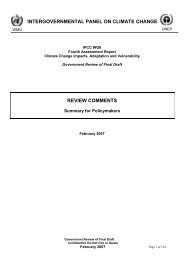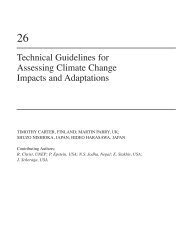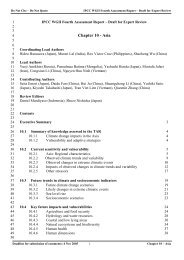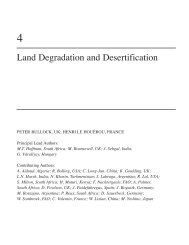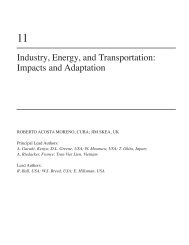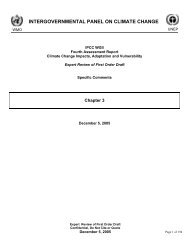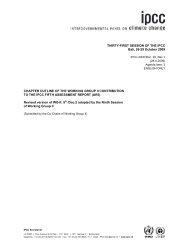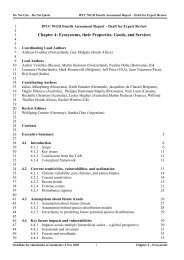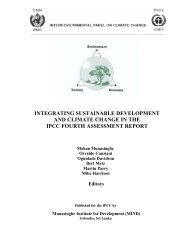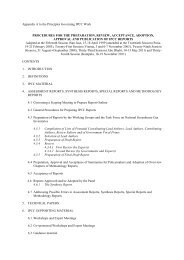IPCC Expert Meeting on Geoengineering
IPCC Expert Meeting on Geoengineering
IPCC Expert Meeting on Geoengineering
Create successful ePaper yourself
Turn your PDF publications into a flip-book with our unique Google optimized e-Paper software.
Annex 4: Poster Abstracts<br />
Categorizati<strong>on</strong> of policy resp<strong>on</strong>ses to climate change with a focus <strong>on</strong><br />
geoengineering<br />
Olivier Boucher 1 * and Piers Forster 2<br />
1<br />
Laboratoire de Météorologie Dynamique, IPSL / CNRS / Université P. et M. Curie, Paris, France<br />
2<br />
University of Leeds, United Kingdom<br />
Potential policy resp<strong>on</strong>ses to anthropogenic climate change can be broadly classified into four categories: additi<strong>on</strong>al<br />
research into climate sciences and carb<strong>on</strong>-free or carb<strong>on</strong>-neutral sources of energy, mitigati<strong>on</strong> (i.e. reducti<strong>on</strong> in<br />
anthropogenic emissi<strong>on</strong>s of greenhouse gases), adaptati<strong>on</strong> (i.e. reducti<strong>on</strong> of the impacts of climate change <strong>on</strong> natural and<br />
societal systems), and geoengineering.<br />
<strong>Geoengineering</strong> is usually defined as the intenti<strong>on</strong>al large-scale manipulati<strong>on</strong> of some element of the Earth system, in an<br />
attempt to counteract the effects of anthropogenic climate change. It is sometimes also referred to as climate interventi<strong>on</strong>,<br />
climate engineering or planetary engineering. To qualify as geoengineering, an interventi<strong>on</strong> into the Earth system has to<br />
deliberately attempt to tackle climate change by a method that does not seek to reduce anthropogenic emissi<strong>on</strong>s of<br />
greenhouse gases or other warming agents. For instance, the emissi<strong>on</strong> of anthropogenic aerosols from burning fossil fuels,<br />
although resp<strong>on</strong>sible for a cooling effect, is not c<strong>on</strong>sidered to be geoengineering because it is a by-product of our industrial<br />
and transportati<strong>on</strong> systems rather than a deliberate acti<strong>on</strong>. The interventi<strong>on</strong>, although it can be localized, also has to have<br />
a large-scale effect <strong>on</strong> the climate system. This clearly distinguishes geoengineering from, e.g., weather modificati<strong>on</strong> or<br />
other sorts of envir<strong>on</strong>mental engineering which attempt to modify the atmosphere or the land surface <strong>on</strong> a much smaller<br />
scale.<br />
A number of geoengineering schemes have been proposed in the scientific literature. Their technological maturity,<br />
effectiveness, scalability, residual impacts, unintended c<strong>on</strong>sequences and cost vary a great deal and remain uncertain. The<br />
Royal Society report (2009) <strong>on</strong> geoengineering categorized geoengineering schemes into solar radiati<strong>on</strong> management<br />
(SRM) and carb<strong>on</strong> dioxide removal (CDR) techniques. SRM schemes seek to artificially modify the solar radiati<strong>on</strong> budget to<br />
cool the planet. CDR schemes seek to artificially remove carb<strong>on</strong> dioxide from the atmosphere and store it in some form.<br />
While the distincti<strong>on</strong> between SRM and CDR is useful, it does not cover all potential geoengineering schemes <strong>on</strong>e can think<br />
of. For instance, it has been suggested that the terrestrial radiati<strong>on</strong> budget could also be artificially modified through<br />
changes in cirrus clouds and/or atmospheric water vapor in order to decrease the greenhouse effect. Carb<strong>on</strong> dioxide is not<br />
the <strong>on</strong>ly l<strong>on</strong>g-lived greenhouse gas in the atmosphere, and air removal can also be envisaged for methane (Boucher and<br />
Folberth, 2009) or other gases.<br />
Figure A.4.2 lists a large number of approaches to climate change and attempts to refine their groupings into distinct<br />
categories. It appears that there is not always a clear divisi<strong>on</strong> between geoengineering and adaptati<strong>on</strong> or between<br />
geoengineering and c<strong>on</strong>venti<strong>on</strong>al mitigati<strong>on</strong>. For instance, it has been suggested that the Earth’s albedo could be artificially<br />
increased over land by increasing the reflectivity of human dwellings (Akbari et al., 1999) or cropland (Ridgwell et al.,<br />
2009). These modificati<strong>on</strong>s may actually be more relevant to local and regi<strong>on</strong>al adaptati<strong>on</strong> to climate change than<br />
geoengineering. Furthermore the fr<strong>on</strong>tier between geoengineering and mitigati<strong>on</strong> is not very clear when it comes to<br />
biofuels. The large-scale exploitati<strong>on</strong> of biofuels associated with carb<strong>on</strong> capture and storage (CCS) has the potential to<br />
remove CO 2 from the atmosphere and qualifies as a CDR scheme, even though biofuels and CCS <strong>on</strong> their own are usually<br />
c<strong>on</strong>sidered as c<strong>on</strong>venti<strong>on</strong>al mitigati<strong>on</strong> tools.<br />
In c<strong>on</strong>clusi<strong>on</strong> we argue that it is important to develop a clear terminology <strong>on</strong> policy resp<strong>on</strong>ses to climate change, while<br />
recognizing that the fr<strong>on</strong>tier between these resp<strong>on</strong>ses is not always clear-cut. We will provide in this presentati<strong>on</strong> a first<br />
attempt at developing such a terminology. This will help to decide how geoengineering should fit (or not) in the portfolio of<br />
existing climate change policies. Multiple factors have to be c<strong>on</strong>sidered when comparing these policy resp<strong>on</strong>ses, including<br />
their technological maturity, effectiveness, scalability, timescale for implementati<strong>on</strong>, risk, residual climate change,<br />
unintended c<strong>on</strong>sequences, degree of interference with the climate system, the policy and governance challenges they pose,<br />
and their cost.<br />
References<br />
Akbari H., S. K<strong>on</strong>opacki, and M. Pomerantz, 1999: Cooling energy savings potential of reflective roofs for residential and<br />
commercial buildings in the United States. Energy 24, 391–407.<br />
<str<strong>on</strong>g>IPCC</str<strong>on</strong>g> <str<strong>on</strong>g>Expert</str<strong>on</strong>g> <str<strong>on</strong>g>Meeting</str<strong>on</strong>g> <strong>on</strong> <strong>Geoengineering</strong> - 45



